Hybrid Engines: The Definitive Guide to Performance and Fuel Economy

Understanding Hybrid Technology
The road ahead is green, and it’s powered by a fascinating blend of old and new. Did you know that in 2023, hybrid vehicle sales in the U.S. surged by an incredible 60% compared to the previous year, reaching nearly 1.2 million units? This remarkable growth isn’t just a fleeting trend; it’s a clear signal that more and more drivers are discovering the undeniable advantages of hybrid technology. Gone are the days when hybrids were niche vehicles associated with sluggish performance. Today, they represent the best of both worlds: the reliable power of a traditional gasoline engine coupled with the groundbreaking efficiency of an electric motor.
This guide is designed to be your definitive resource for all things hybrid, taking you beyond the headlines and into the mechanics of what makes these vehicles so compelling. We’ll delve deep into understanding hybrid engine performance, unraveling how they deliver that surprising acceleration and smooth driving experience. We’ll also meticulously explore their exceptional fuel economy, showing you how hybrids can significantly reduce your load at the gas pump. Most importantly, as a leading provider of quality used auto parts, Automotix is uniquely positioned to help you navigate the landscape of used hybrid engines. Whether you’re considering a hybrid for your next vehicle, looking to optimize your current one, or a mechanic seeking reliable replacement parts, we’re here to equip you with the knowledge to make smart, informed choices every step of the way.
Summary
This guide from Automotix provides an in-depth look at hybrid engines, covering everything from
their fundamental workings to their real-world benefits. You’ll discover:
- How they work: Learn about the clever partnership between a gasoline engine and electric motor(s), and the key components like the high-voltage battery, generator, and the intelligent Power Control Unit (PCU) that manages it all.
- Key advantages: Understand why hybrids offer unparalleled fuel economy through features like regenerative braking and automatic start/stop systems, and how the instant torque from electric motors provides surprising performance and responsiveness.
- Different types of hybrids: Explore the distinctions between Mild, Full, and Plug-in Hybrids, as well as Series, Parallel, and Series-Parallel configurations, to understand how each system blends power.
- Why used makes sense: Find out why a quality used hybrid engine can be a smart, cost-effective choice for replacement, and what crucial factors like mileage, vehicle history, and compatibility to look for when buying.
- Maintenance insights: Get answers to common questions about hybrid vehicle care, including oil change frequency and how hybrids operate if the high-voltage battery is depleted.
Table of Contents
- What is a Hybrid Engine and How Does it Work?
- Different Types of Hybrid Systems
- Benefits of Hybrid Engines
- Used Hybrid Engines vs. New Hybrid Engines: What Should You Consider?
- What to Look For When Buying a Used Hybrid Engine
- Our Sourcing and Testing Process
- Fast and Reliable Delivery Across the USA
- Let Us Help You Find the Right Part
- Frequently Asked Questions About Hybrid Engines
1. What is a Hybrid Engine and How Does it Work?
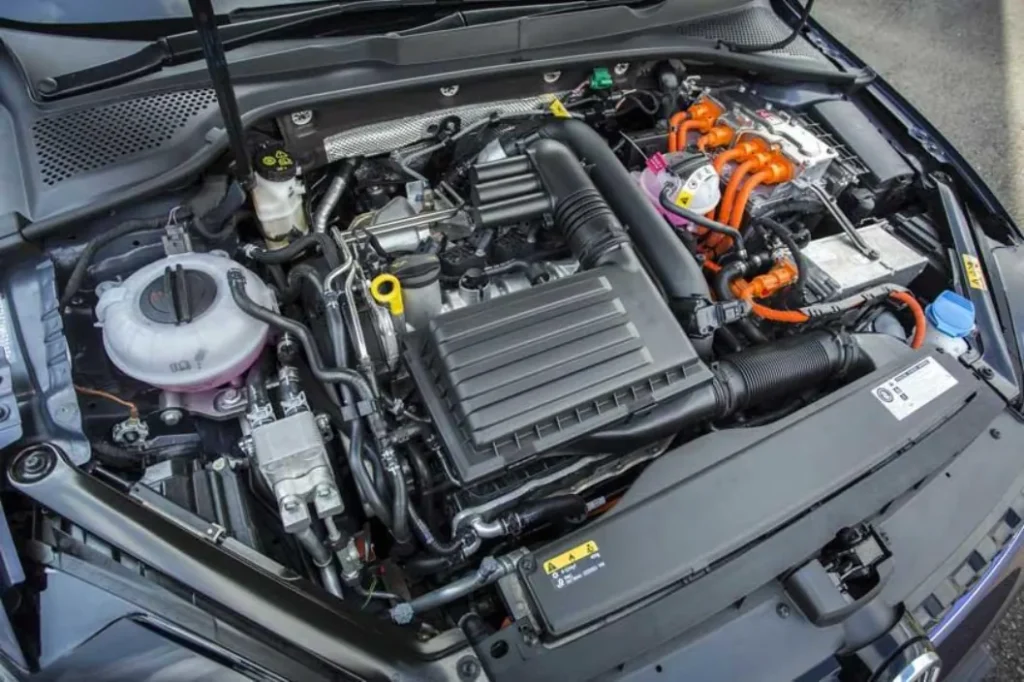
Imagine you’re on a bicycle, pedaling along. Now, picture that bicycle having a secret superpower: a small electric motor that kicks in automatically when you need an extra push like going uphill, or when you’re tired and just want to cruise effortlessly on flat ground. When you’re coasting downhill, that electric motor even helps recharge its own battery. That’s essentially how a hybrid engine works, but for your car! It’s a clever partnership between two distinct power sources working together to give you the best of both worlds: power when you need it, and incredible efficiency when you don’t.
So, what are the key players in this highly efficient automotive team? Let’s break down the core components:
Internal Combustion Engine (ICE)
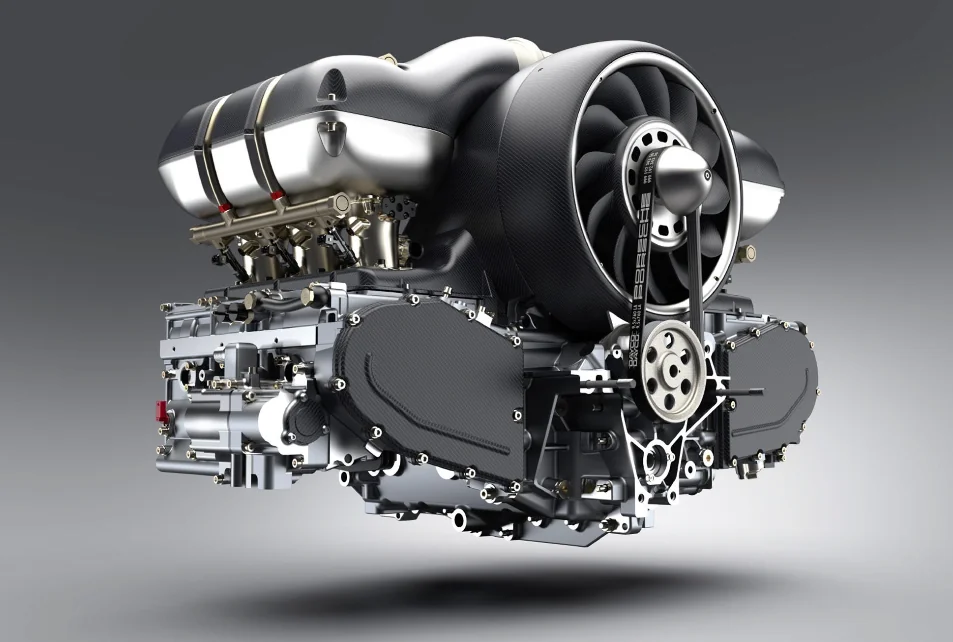
This is the gasoline-powered engine you’re already familiar with. In a hybrid, it’s often a smaller, more efficient version than what you’d find in a traditional car, designed to work optimally at specific speeds and conditions. It’s the primary workhorse for longer distances and higher speeds.
Electric Motors(s)
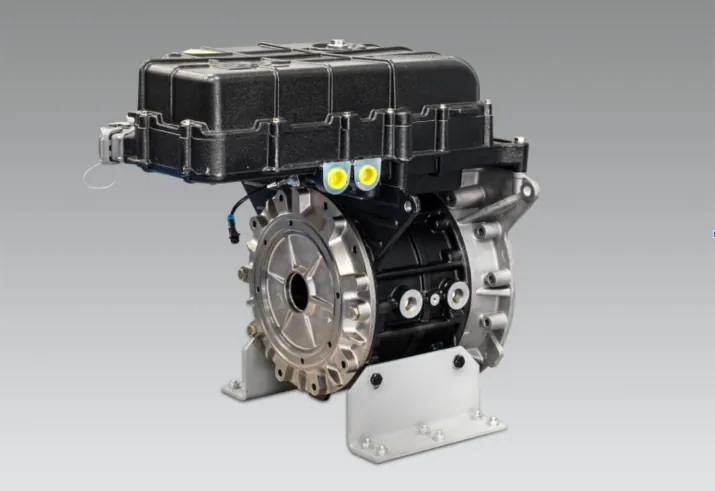
This is where the “hybrid” magic truly shines. Hybrids use one or more electric motors that can propel the vehicle entirely on electric power at low speeds, assist the gasoline engine during acceleration, and even act as a generator during deceleration. The instant torque from an electric motor is a big reason why hybrids often feel surprisingly dynamic off the line.
Battery Pack (High-Voltage Battery)
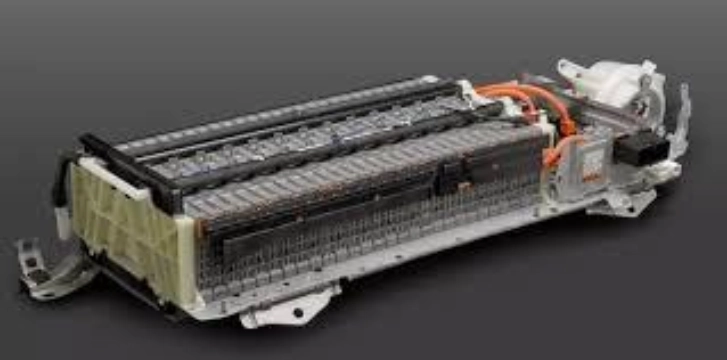
Unlike your car’s standard 12-volt battery that just starts the engine, this is a much larger, high-voltage battery specifically designed to store and supply power to the electric motor(s). These batteries are typically made of nickel-metal hydride (NiMH) or lithium-ion (Li-ion) and are strategically placed within the vehicle, often under the rear seats or trunk floor, to optimize weight distribution and safety.
Generator
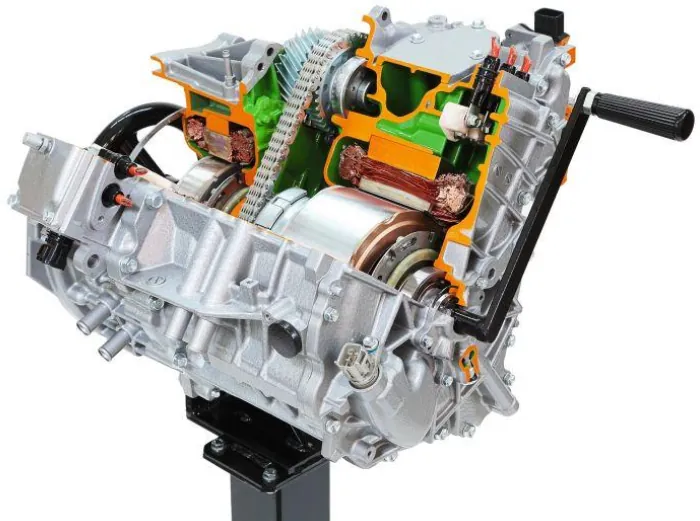
Often integrated with the electric motor, the generator’s main role is to convert mechanical energy (from the gasoline engine or regenerative braking) into electrical energy to recharge the high-voltage battery. It’s like a tiny power plant on wheels.
Power Control Unit (PCU)
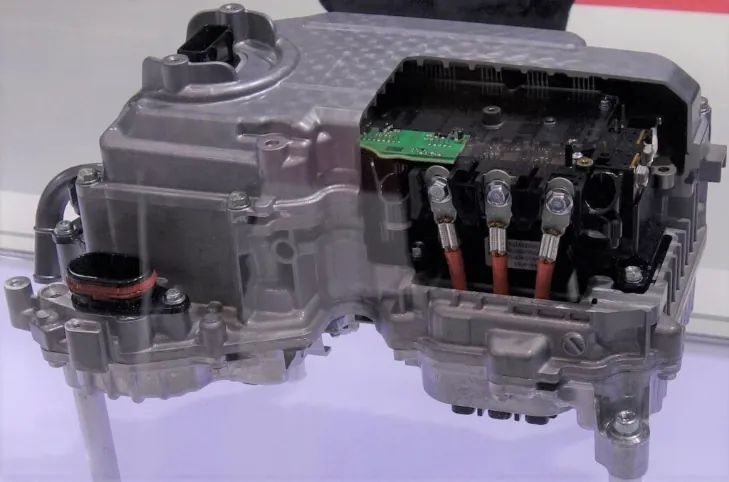
A power control unit (PCU) for a hybrid vehicle, with a portion of the casing removed to show internal electronic components and wiring.
Think of this as the brain of the hybrid system. The PCU is a sophisticated computer system that constantly monitors driving conditions, driver input, and the state of charge of the battery. It seamlessly decides when to use the gasoline engine, when to use the electric motor, when to combine both, and when to recharge the battery. This intelligent management is what makes a hybrid system so smooth and efficient.
Different Types of Hybrid Systems
Just like there are different types of coffee or different models of smartphones, there are several distinct types of hybrid systems, each with its own approach to blending gasoline and electric power. Understanding these differences is key to appreciating how hybrids perform and how they might fit into your driving habits.
Mild Hybrids (mHEV)
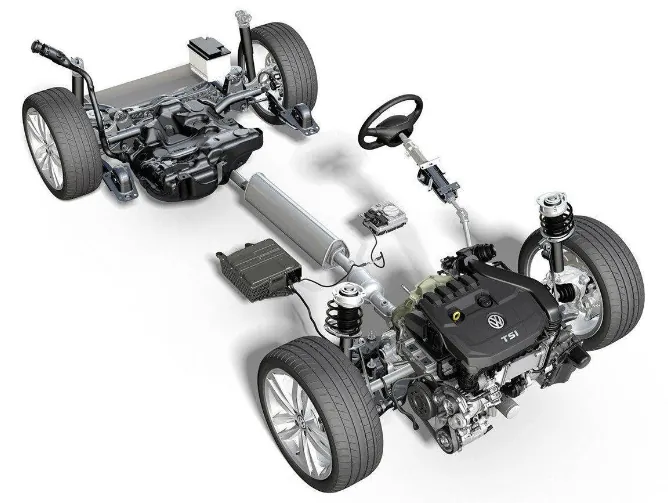
An exploded view diagram of a car chassis, showing the layout of the engine, wheels, suspension, and other major components.
Think of a mild hybrid as a supportive sidekick to the gasoline engine. These systems use a smaller electric motor and battery than other hybrids. Their primary role isn’t to power the car independently, but rather to assist the internal combustion engine. This assistance comes in handy during acceleration, reducing the strain on the gasoline engine and improving fuel efficiency. Mild hybrids are also excellent at enabling features like advanced automatic start/stop systems, which seamlessly shut off the engine when the car is stopped and restart it quickly. However, a crucial point is that mild hybrids cannot propel the vehicle using electric power alone. They always rely on the gasoline engine for propulsion.
Full Hybrids (HEV)
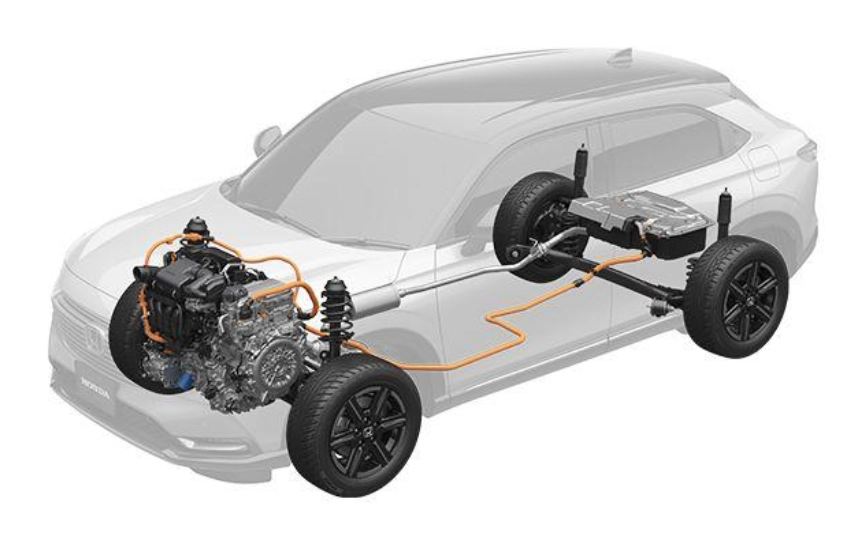
This is perhaps the most common type of hybrid you’ll encounter, exemplified by popular models like the Toyota Prius. Full hybrids feature more powerful electric motors and larger battery packs than mild hybrids. This allows them to do something mild hybrids can’t: drive for short distances on electric power alone, typically at low speeds (e.g., in stop-and-go traffic or while parking). The system intelligently switches between electric-only, gasoline-only, or a combination of both, optimizing for efficiency. Regenerative braking plays a significant role in full hybrids, capturing energy normally lost during deceleration and converting it back into electricity to recharge the battery.
Plug-in Hybrids (PHEV)
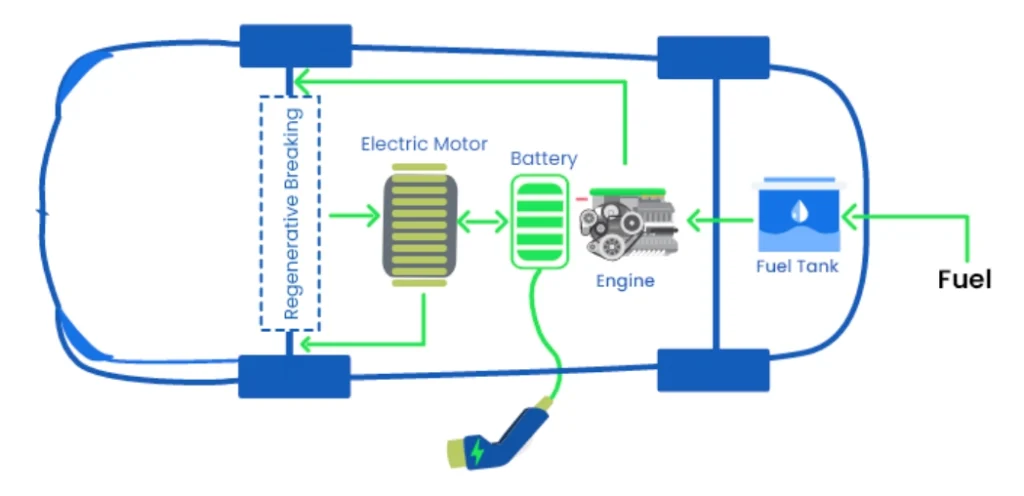
Taking the hybrid concept a significant step further, plug-in hybrids are designed with even larger battery packs and, as the name suggests, the ability to be plugged into an external power source to recharge. This larger battery capacity means PHEVs can travel a much more substantial distance on electric power alone – often 20 to 50 miles or more, depending on the model – before the gasoline engine even needs to kick in. This makes them ideal for daily commutes, potentially allowing drivers to use little to no gasoline for their everyday driving. Once the electric range is depleted, a PHEV operates much like a full hybrid, using its gasoline engine and regenerative braking.
Beyond these broad categories, hybrid systems can also be classified by how their components work together to deliver power to the wheels:
Series Hybrid
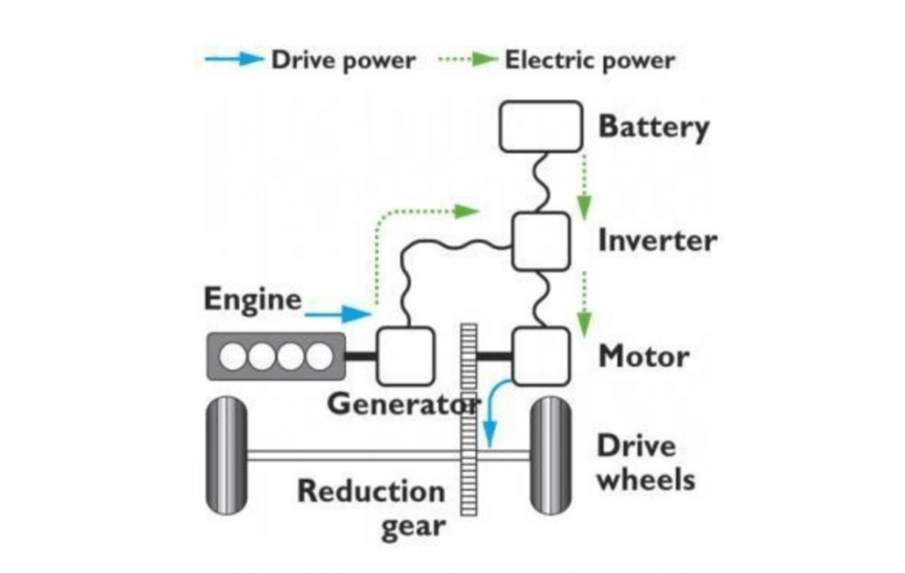
generator, which then provides electricity to the motor that drives the wheels.
In a series hybrid, the gasoline engine doesn’t directly power the wheels. Instead, it acts as a generator, creating electricity that either charges the battery or directly powers the electric motor(s) that propel the car. Think of it like a train: the diesel engine powers a generator, and the generator powers electric motors that move the train. This system offers very smooth power delivery and can operate the gasoline engine at its most efficient RPM.
Parallel Hybrid
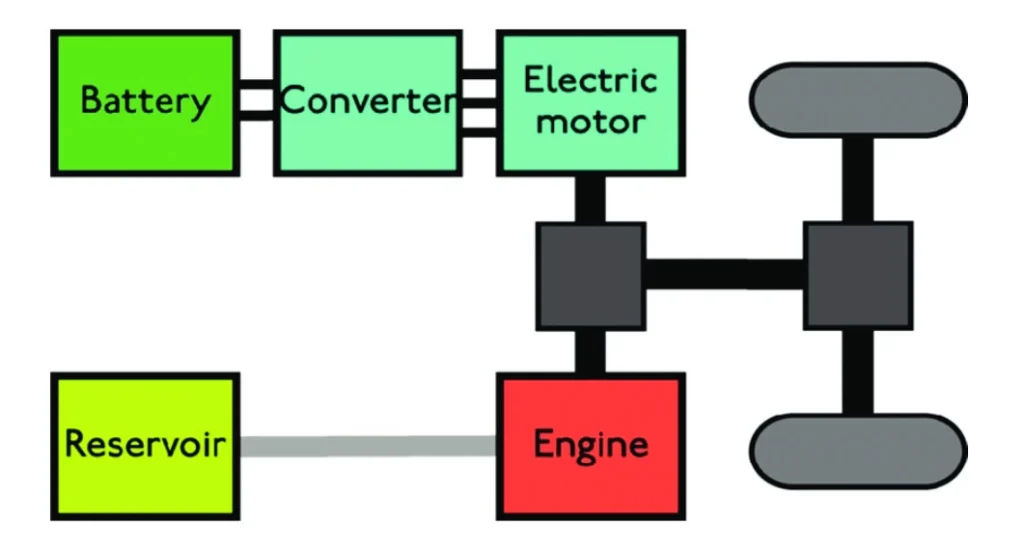
In a parallel hybrid, both the electric motor and the gasoline engine can directly power the wheels, either independently or together. This setup often uses a more traditional transmission. The system’s computer decides which power source, or combination, is most efficient for the given driving conditions. It’s like having two separate engines that can work in tandem.
Series-Parallel (Power-Split) Hybrid
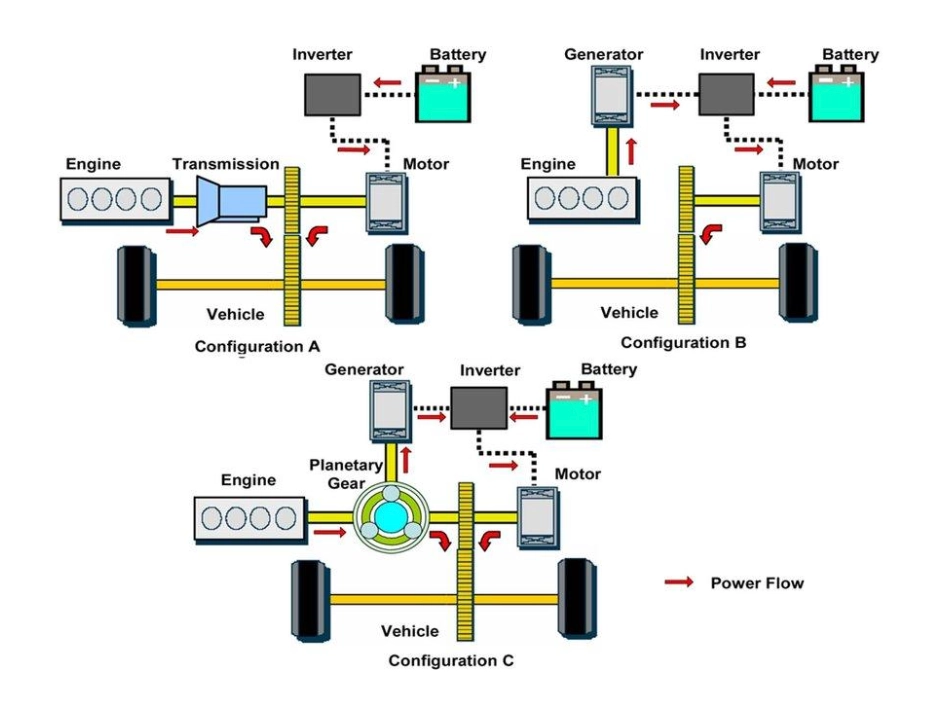
Often considered the most sophisticated and efficient design, this system combines elements of both series and parallel configurations. It uses a planetary gear set (often referred to as a “power-split device”) to seamlessly blend power from the gasoline engine and electric motors. This allows for incredible flexibility: the car can run on electric-only, gasoline-only, or a combination, and the gasoline engine can simultaneously power the wheels and charge the battery. This design is famously used by Toyota in their Hybrid Synergy Drive system.
Benefits of Hybrid Engines
Fuel Economy
One of the most compelling reasons drivers choose a hybrid vehicle is the significant relief it offers at the gas pump. It’s not just about getting more miles per gallon; it’s about the ingenious ways hybrid technology optimizes every drop of fuel. Two core technologies are largely responsible for this remarkable efficiency:
Regenerative Braking
In a traditional gasoline car, every time you press the brake the friction from the brake pads converts kinetic energy (the energy of motion) into heat, which is then wasted. Hybrids, however, cleverly recapture much of this otherwise lost energy. When you lift your foot off the accelerator or lightly press the brake pedal, the electric motor reverses its function, acting as a generator. It converts the vehicle’s kinetic energy back into electricity, which is then stored in the high-voltage battery. This not only recharges the battery, making more electric power available for propulsion, but also reduces wear and tear on your conventional brake pads. It’s like giving your car’s battery a little boost every time you slow down.
Automatic Start/Stop Systems
You know how your engine idles at a red light, burning fuel for no forward motion? Hybrids eliminate this waste. When the vehicle comes to a complete stop, the gasoline engine automatically shuts off, conserving fuel and reducing emissions. The moment you lift your foot off the brake, or press the accelerator, the electric motor seamlessly and silently restarts the engine (or propels the car on electric power first), often before you even realize it. This feature is particularly effective in stop-and-go city traffic, where idling time can significantly impact fuel economy.
Performance
For a long time, there was a widespread misconception that hybrids were inherently slow or lacked power. This couldn’t be further from the truth in today’s market. Modern hybrid engines deliver a surprisingly engaging and often superior driving experience that goes well beyond just fuel savings.
Let’s debunk the myth that hybrids are slow. While early hybrid models might have prioritized efficiency above all else, contemporary hybrids often use their electric motors to enhance performance, not hinder it. Many hybrid vehicles, particularly those with parallel or series-parallel systems, can deliver robust acceleration, sometimes even outperforming their conventional gasoline counterparts, especially in city driving. The combination of gasoline engine power and instant electric torque provides a unique sensation that many drivers find enjoyable.
The secret ingredient to a hybrid’s high performance lies in the instant torque from the electric motor. Unlike a gasoline engine, which needs to rev up to a certain RPM to produce its maximum torque (the twisting force that gets your car moving), an electric motor delivers 100% of its torque from a standstill. This means when you press the accelerator, you get immediate, forceful propulsion, leading to quicker off-the-line acceleration and a feeling of effortless power, particularly at lower speeds. This characteristic makes hybrids feel remarkably responsive in urban environments and during stop-and-go traffic.
Used Hybrid Engines vs. New Hybrid Engines: What Should You Consider?
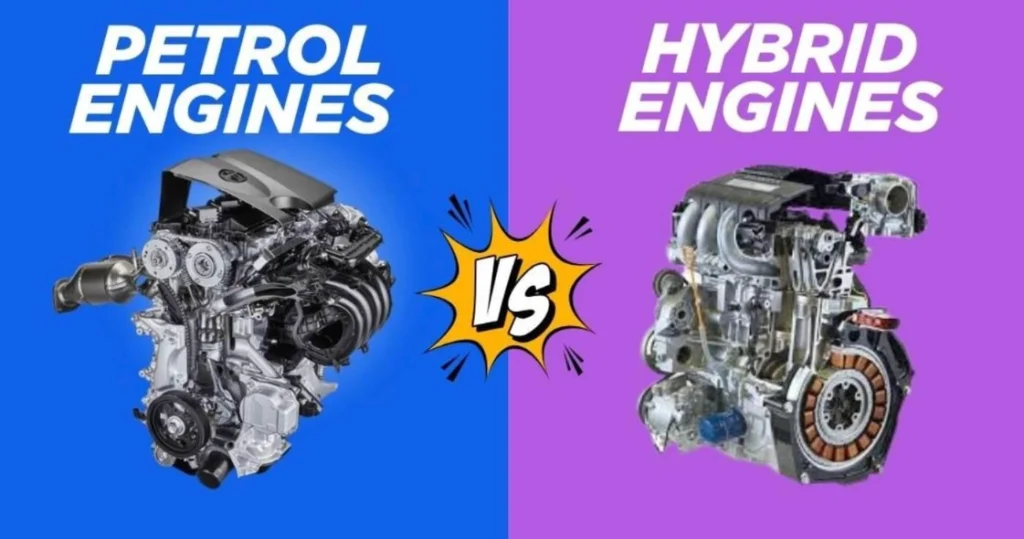
When faced with the need for a hybrid engine replacement, the fundamental choice boils down to new versus used. Both options have distinct advantages and disadvantages, and the best decision for you will depend on your budget, priorities, and the overall condition of your vehicle. Let’s break down the key factors to consider.
The Case for a New Hybrid Engine
Zero Miles, Peak Performance
A new engine comes with zero miles, meaning it’s in pristine condition. You get the manufacturer’s latest design, materials, and engineering, ensuring optimal performance and fuel efficiency right out of the box.
Full Manufacturer Warranty
New engines typically come with a comprehensive manufacturer’s warranty, often covering several years or tens of thousands of miles. This provides the highest level of peace of mind against manufacturing defects or premature failure.
Latest Technology
New engines might incorporate subtle improvements in efficiency, emissions control, or power delivery that have been introduced since your vehicle was originally manufactured.
Guaranteed Compatibility (if OEM)
If you’re buying a new Original Equipment Manufacturer (OEM) engine, it’s guaranteed to be a perfect fit and match for your vehicle’s specific make, model, and year.
However, the primary drawback of a new hybrid engine is its cost. This can be prohibitively expensive, sometimes exceeding the actual market value of an older vehicle, making the repair financially illogical.
The Case for a Quality Used Hybrid Engine
Significant Cost Savings
This is the most impactful advantage. A used hybrid engine can cost 50% to 70% less than a brand-new one. This massive saving can make the difference between scrapping a perfectly good car and getting it back on the road for many more years. For many vehicle owners, this financial practicality is paramount.
Environmental Responsibility
Choosing a used engine is a truly sustainable choice. It reduces the demand for new manufacturing, conserving raw materials, energy, and minimizing waste that would otherwise end up in landfills. It’s an eco-friendly decision that aligns with the very spirit of hybrid technology.
Proven Performance (from reputable sources)
A quality used engine, particularly one sourced from a low-mileage donor vehicle and thoroughly inspected, has already proven its operational capabilities. When purchased from a reputable supplier like Automotix, you’re getting a reliable component.
Availability
For older or less common hybrid models, finding a new engine directly from the manufacturer might be challenging or involve long lead times. The vast networks of used parts suppliers, like Automotix, often have the specific engine you need readily available.
What Should You Consider When Making Your Decision?
1. What’s Your Budget?
If cost is your primary concern, a quality used hybrid engine will almost always be the more financially sensible choice. Factor in not just the engine price, but also shipping and installation costs.
2. What’s the Value of Your Vehicle?
If your hybrid vehicle is an older model with significant mileage, investing in a new, high-cost engine might not make economic sense. A used engine often provides a better return on investment for vehicles with lower resale values.
3. How Long Do You Plan to Keep the Vehicle?
If you intend to drive the car for many more years, a new engine offers maximum longevity. However, if you only need a few more years of reliable service, a well-maintained used engine can easily provide that.
4. What’s the Reputation of the Used Parts Supplier?
This is perhaps the most critical factor when considering a used engine. Always choose a supplier with a proven track record, comprehensive inspection processes, transparent policies, and a strong warranty, just like Automotix. Avoid sellers who offer parts “as-is” with no guarantees.
5. Is the Used Engine Compatible and Verified?
Ensure the used engine is an exact match for your vehicle’s VIN, model, and year. A reputable supplier will verify this for you.
6. Are You Comfortable with a “Used” Component?
While quality used engines are excellent value, some individuals simply prefer the absolute peace of mind that comes with a brand-new part. Acknowledge your own comfort level.
4. What to Look For When Buying a Used Hybrid Engine
Mileage and Vehicle History
While mileage is an important indicator for any used engine, for hybrids, it’s crucial to also consider the source vehicle’s history. A lower mileage engine from a vehicle involved in a rear-end collision, for example, might be in excellent shape. Conversely, a high-mileage engine from a well-maintained fleet vehicle could still have plenty of life left. Always inquire about the donor vehicle’s year, make, model, and any available history reports to get the complete picture.
Compatibility
Precision is Paramount. This cannot be stressed enough: matching the engine to your exact vehicle model and year is absolutely critical. Hybrid systems are highly integrated, and even subtle differences between model years or trim levels can mean an engine won’t fit or function correctly. Always provide the VIN (Vehicle Identification Number) of your vehicle when inquiring about a used hybrid engine. A reputable supplier like Automotix will use this to ensure 100% compatibility, preventing costly errors and installation headaches.
Included Components
A “long block” engine typically includes the block, cylinder head, camshaft, and crankshaft. However, for a hybrid engine, you need to clarify what hybrid-specific components are included. Ask if essential items like the wiring harnesses, sensors, throttle body, and any integrated motor/generator units are part of the package. The more components that come with the engine, the easier and often less expensive the installation process will be.
Why Automotix is Your Best Source for Used Hybrid Engines

We’ve explored how a quality used hybrid engine can be a smart, cost-effective, and environmentally friendly solution for many automotive needs. Now, let’s look at why Automotix.net stands out as the premier destination for finding that perfect hybrid engine. Our commitment to quality, extensive selection, expert support, and reliable service is designed to give you complete peace of mind with your purchase.
Our Sourcing and Testing Process
Quality isn’t just a buzzword for us; it’s the foundation of our operation, especially when it comes to the intricate nature of hybrid technology. We understand that the reliability of a used hybrid engine hinges on its origin and the rigorous scrutiny it undergoes before it ever reaches our inventory.
We partner with a nationwide network of reputable salvage yards and automotive recyclers. Our acquisition specialists meticulously select donor vehicles based on various criteria, prioritizing those with verifiable low mileage, non-impacted engine compartments (in the case of accident vehicles), and clear maintenance histories where available. For hybrid engines specifically, we pay close attention to the overall condition of the donor vehicle’s hybrid system components.
Extensive Inventory
Thanks to our vast network of partners across the USA, our inventory is constantly updated, providing unparalleled access to used hybrid engines from virtually every make, model, and year. Whether you drive a popular Toyota Prius, a Ford Escape Hybrid, a Honda Insight, or a more specialized hybrid model, you’re highly likely to find a compatible engine in our system.
Our intuitive online search platform allows you to quickly narrow down options by vehicle make, model, and year, ensuring you find the precise match for your vehicle’s specifications. We utilize the industry-standard Hollander Interchange Cataloging system to ensure precise compatibility, including critical hybrid system distinctions, taking the guesswork out of your purchase and preventing costly fitment errors.
Expert Support for Hybrid Systems
Our customer service representatives aren’t just order-takers; they are knowledgeable experts who can help you verify compatibility using your VIN and engine codes, answer technical questions specific to hybrid drivetrains, and guide you through the selection process. We understand the nuances of hybrid systems, from mild hybrids to plug-ins, and can assist with your specific needs.
Warranty and Customer Satisfaction
Unlike some suppliers, Automotix.net offers comprehensive warranties on our used hybrid engines. This warranty is a direct reflection of our confidence in our sourcing and testing processes, providing crucial protection for your investment in a complex component. We believe that a reliable used part should come with reliable backing, especially for hybrid technology.
Our warranty and return policies are straightforward and transparent, ensuring you understand your coverage and options. In the rare event of an issue, our dedicated support team is ready to assist you through the resolution process, striving for your complete satisfaction.
Fast and Reliable Delivery Across the USA
Automotix utilizes a network of trusted freight carriers to ensure your used hybrid engine reaches you quickly and safely, no matter where you are in the contiguous USA. Every engine is professionally packed and secured to prevent damage during transit, ensuring it arrives at your mechanic’s shop or your doorstep in the same condition it left our facility. We provide tracking information so you can monitor your shipment’s progress, keeping you informed until your engine arrives.
Automotix’s Nationwide Network for Hybrid Engines
While guaranteed compatibility is crucial, Automotix goes a step further. Our nationwide network of professional auto recyclers and suppliers means we don’t just find a hybrid engine that fits your application; we often provide multiple options for the same vehicle. This allows you to choose an engine based on various factors beyond just fit, such as mileage, specific quality assurances, and even price points, ensuring you get the best possible value that aligns with your needs and budget. We empower you with choices, so you’re not just getting a replacement part, but the right replacement part for your unique hybrid vehicle.
Conclusion
We’ve covered a lot of ground in this definitive guide to hybrid engines, from the foundational principles of how they work to the specific benefits they offer in performance and fuel economy. We’ve seen how these intelligent systems, with their seamless blend of gasoline and electric power, deliver impressive MPG figures and surprisingly responsive driving dynamics, debunking old myths about hybrids being underpowered.
Crucially, we’ve also highlighted why a used hybrid engine from a trusted source like Automotix is not just a viable option, but often the smartest and most cost-effective choice for repairs or replacements. By choosing quality used parts, you benefit from significant cost savings, contribute to environmental sustainability through reuse, and gain access to a vast inventory that makes finding the right part easier than ever.
At Automotix, our commitment is to provide meticulously inspected, high-quality used parts that meet stringent standards, backed by transparent warranty and return policies. We understand the intricacies of hybrid technology and are dedicated to ensuring you get the right part for your vehicle, enabling you to get back on the road with confidence.
Let Us Help You Find the Right Part
Understanding hybrid engines is the first step; finding the perfect replacement part is the next Automotix is here to make that process as smooth and reliable as possible.
Have questions about hybrid engines, specific models, or compatibility? Our expert team, with deep knowledge of auto parts and hybrid systems, is here to help guide you. Don’t hesitate to contact us today – we’re ready to provide the answers and support you need.
Ready to find your engine and experience the Automotix advantage firsthand? Use our powerful, user-friendly search tool to browse millions of parts and quickly locate the exact used hybrid engine you’re looking for. Your ideal part is just a few clicks away!
Frequently Asked Questions About Hybrid Engines
Here are some common questions we hear about hybrid engines and their maintenance, with straightforward answers to help you better understand this evolving technology.
Q: How long do hybrid car batteries typically last?
A: Hybrid batteries are designed for longevity and often last for the entire lifespan of the vehicle. Most manufacturers provide warranties for hybrid batteries of at least 8 years or 100,000 miles, with some extending to 10 years or 150,000 miles in certain states. In reality, many hybrid batteries on the road today have far exceeded these warranty periods, demonstrating impressive durability, especially with proper care and favorable driving conditions.
Q: Is it expensive to replace a hybrid battery?
A: While the cost of a new hybrid battery replacement can range from $2,000 to $8,000 or more depending on the make, model, and battery type (NiMH vs. Li-ion), it’s important to remember that this is a relatively rare occurrence. Battery failures are infrequent, and if your vehicle is otherwise in good condition, replacing the battery can be a far more cost-effective solution than buying a new car. Additionally, the market for remanufactured and reconditioned hybrid batteries (which Automotix may also offer in the future) is growing, providing more affordable options.
Q: Do hybrid cars require special maintenance that makes them more expensive to own?
A: For routine maintenance, hybrid cars are generally not more expensive to own than traditional gasoline cars; in many cases, they can be less so. The gasoline engine often runs less, leading to longer intervals for oil changes and less wear on components. Crucially, the regenerative braking system significantly extends the life of brake pads and rotors. While hybrids do have specific needs, like specialized coolants for their electric components, these are typically part of a standard service schedule.
Q: How often should I change the oil in my hybrid vehicle?
A: The frequency of oil changes for a hybrid depends on the manufacturer’s recommendations for your specific model, which you’ll find in your owner’s manual. However, because the gasoline engine in a hybrid doesn’t run continuously, oil change intervals are often extended compared to conventional cars, sometimes ranging from 7,500 to 10,000 miles or once a year. Always use the recommended oil type and viscosity.
Q: Can I drive a hybrid car if the battery is completely dead?
A: In most full hybrids (HEVs), if the high-voltage battery system completely fails or degrades significantly, the vehicle will typically revert to running on its gasoline engine. However, its efficiency will be greatly reduced, and you may experience warning lights or a “limp home” mode. Plug-in hybrids (PHEVs) can also run on gasoline after their electric range is depleted. While a “dead” hybrid battery doesn’t usually mean you’re stranded, it does indicate a need for service to restore optimal performance and fuel economy.
Q: What are the main signs that a used hybrid engine might have problems?
A: When considering a used hybrid engine, look for signs such as excessive corrosion or fluid leaks in photos. Beyond visual cues, common issues with hybrid systems include a noticeable decrease in fuel efficiency, a hybrid battery that no longer holds a charge for long, dashboard warning lights related to the hybrid system, or a vehicle that struggles to switch between gasoline and electric modes. A reputable seller like Automotix will provide detailed inspections and warranty information to mitigate these risks.
Q: Why buy a used hybrid engine from Automotix instead of a brand new one?
A: Choosing a used hybrid engine from Automotix offers compelling advantages: significant cost savings (often 50% or more off the new price), a positive environmental impact by reusing parts, and immediate availability from our vast inventory. We rigorously inspect and test our used engines, providing quality assurance and robust warranty policies, ensuring you receive a reliable part without the premium cost of new.
About the Author / Automotix Team:
This guide was crafted by the seasoned experts at Automotix, a leading name in the used auto parts industry since 2000. With over two decades of dedicated experience, our team has been at the forefront of connecting buyers with high-quality, certified used OEM auto parts across the USA. We pride ourselves on leveraging cutting-edge technology to streamline the auto parts buying experience, offering an unparalleled inventory and a commitment to customer satisfaction that has established us as a trusted authority. Our mission is to empower car owners, DIY mechanics, and repair shops with the knowledge and the right parts to keep vehicles running efficiently and affordably, contributing to both individual savings and a more sustainable automotive future.


